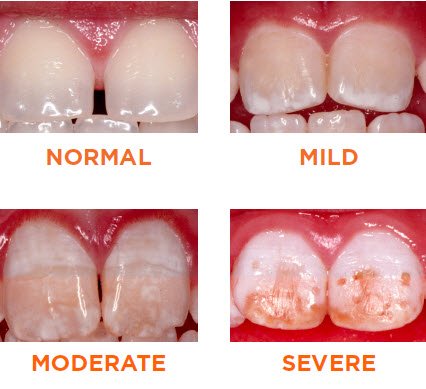DENTAL FLUOROSIS
Dental Fluorosis is hypomineralisation (less mineralized) of tooth enamel caused by ingestion of excessive fluoride during enamel formation i.e. during the formation of outer protective layer of the tooth.
Dental Fluorosis is hypomineralisation (less mineralized) of tooth enamel caused by ingestion of excessive fluoride during enamel formation i.e. during the formation of outer protective layer of the tooth.
It appears as a range of visual changes in enamel causing degrees of tooth discoloration.
In the mildest
form (which is the most common) there are faint white lines or specks. Slightly
more severe cases appear as white mottled patches, while severe fluorosis is
characterized by brown discoloration and brittle, pitted and rough enamel.
.

CAUSES:
Many
well-known sources of fluoride may contribute to overexposure including tooth
paste/fluoridated mouth rinse (which
young children may swallow), bottled waters which are not tested for their
fluoride content, inappropriate use of fluoride supplements, ingestion of foods
especially imported from other countries, and public water fluoridation.
Expected Duration:
The spots and stains left by fluorosis are permanent. They may darken over time.
The spots and stains left by fluorosis are permanent. They may darken over time.
Prevention:
If you have a child under 6, put only a small pea-sized amount of toothpaste on his or her toothbrush. Encourage your child to spit rather than swallow after brushing. Avoid toothpastes with flavors that may encourage swallowing. Keep all fluoride-containing products out of the reach of young children. These include toothpastes and mouthwashes.
If you have a child under 6, put only a small pea-sized amount of toothpaste on his or her toothbrush. Encourage your child to spit rather than swallow after brushing. Avoid toothpastes with flavors that may encourage swallowing. Keep all fluoride-containing products out of the reach of young children. These include toothpastes and mouthwashes.
Children should take fluoride
supplements only if the water they drink does not contain enough fluoride and
they are at high risk for cavities. If your child is taking fluoride
supplements now, get the amount of fluoride in your water checked.
Some foods and drinks contain fluoride.
For example, many fruit juices and soft drinks contain fluoride at levels
similar to fluoridated water. Some bottled waters now have added fluoride. All
of this can add up. It is important to know how much fluoride your child
consumes.
Management :
Dental fluorosis may or may not be of cosmetic concern .The
treatment options are:
· Tooth bleaching
· Micro abrasion
· Composite fillings
· Veneers
· Crowns
KEY POINT:
Remember that fluorosis affects only the appearance of teeth. They are not diseased. It does not result in cavities. As a result, most of the treatment for fluorosis consists of masking the stain.
Remember that fluorosis affects only the appearance of teeth. They are not diseased. It does not result in cavities. As a result, most of the treatment for fluorosis consists of masking the stain.
When To Call a Professional:
If you notice white streaks or spots on your child's teeth or notice that one or more teeth are discolored, contact us at Idyll dental clinic.
To book an appointment call us at,
iDENT Idyll Dental Clinic,
+9140147049,
smileident@gmail.com
If you notice white streaks or spots on your child's teeth or notice that one or more teeth are discolored, contact us at Idyll dental clinic.
To book an appointment call us at,
iDENT Idyll Dental Clinic,
+9140147049,
smileident@gmail.com
No comments:
Post a Comment